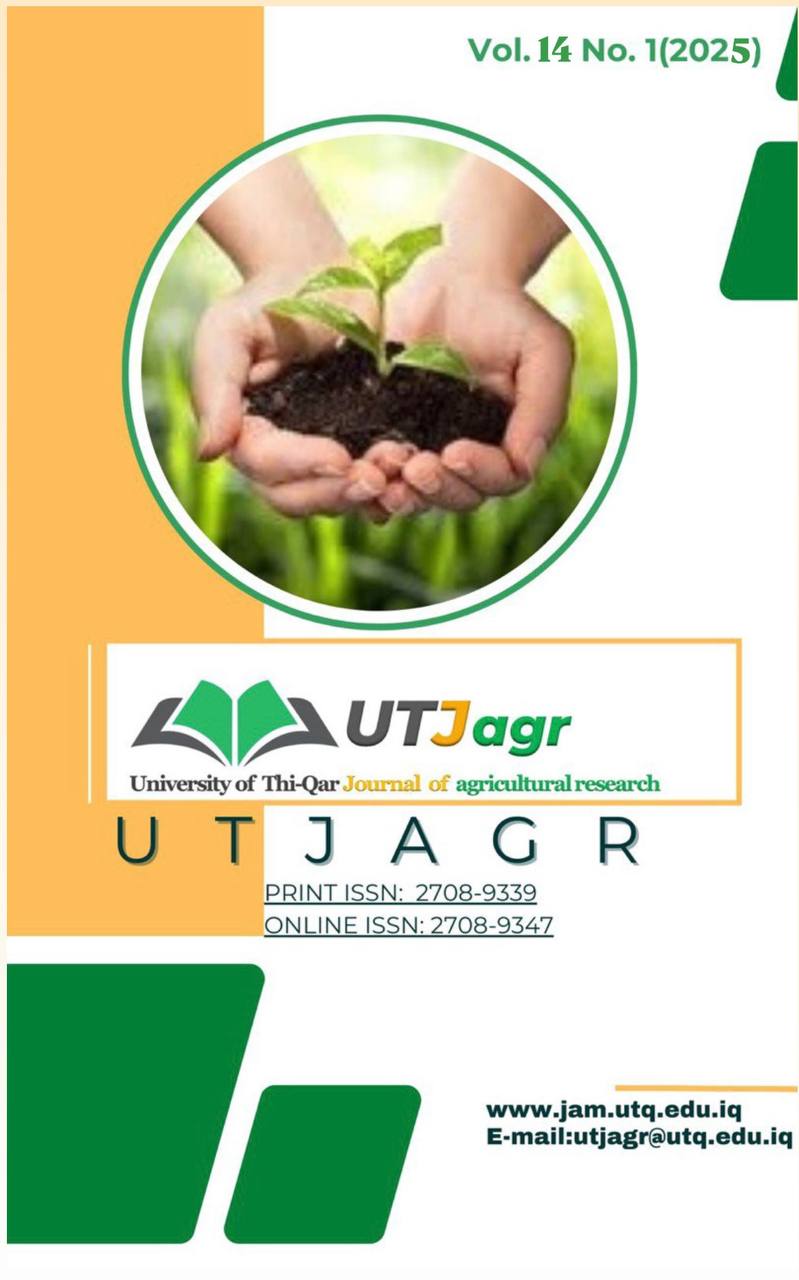Using random amplification polymorphism (RAPD-PCR) markers to determine the genetic variability of some local and tissue cultured date palm Phoenix dactylifera L. cultivars.
DOI:
https://doi.org/10.54174/99b6sd83Keywords:
Random Doubling RAPD, Date Palm, Molecular Traits, PrimersAbstract
This study was conducted during the growing season (2024) in one of the private orchards in Nasiriyah district, the center of Dhi Qar Governorate, at longitude (46.06) and latitude (31.90) on some date palm cultivars produced by tissue culture and their counterparts grown by the offshoot method (traditional method). The aim of this study is to study the molecular characterization and determine the genetic fingerprint of the studied cultivars, which are (local Barhi and produced by tissue culture, local Balka and produced by tissue culture, local Sukkari and produced by tissue culture), in addition to the cultivars produced by tissue culture only (Khalas, Saqai and Majhool).
Study molecular characters by using RAPD technique for (11) primers, And the results were analyzed for the molecular indicators using Photocapt ready-made program package, and then tree cluster analysis was conducted to distinguish between the varieties under study and draw the cluster convergence tree between the cultivars.
The results showed that all the all primers used in the study (HB12, OPA12, OPB07, OPC09, OPC13, OPD10, OPD20, OPH-03, OPH-06, OPK18, and OPN-17) were efficient in determining the genetic fingerprint and finding genetic variation among the studied cultivars. The results showed that all primers gave a total number of bands (530 bands). The primer (OPH03) gave the highest number of bands (61 bands) and the number of different bands among them (51 bands), thus achieving a variation ratio of (83.60%), the highest efficiency ratio of (11.50%), and highest diagnostic power of (14.69%), while the primer (OPN17) gave lowest number of bands (31 bands), the number of different bands among them (17 bands), with contrast ratio of (54.83%), and gave lowest efficiency ratio of (5.84%).
The results of the tree cluster analysis of studied cultivars and all the primers showed that studied cultivars were distributed into two groups. The first group included the cultivars (Khalas, Majhool and Saqai produced by tissue culture), while the second group included the cultivars (local Sukkari and produced by tissue culture, Barhi produced by tissue culture and local, local Balka and produced by tissue culture). The largest genetic distance was recorded by Khalas produced by tissue culture cultivar, which reached (28.8%), and thus it is the most distant genetically from the rest of cultivars, while the cultivars of second group recorded great genetic convergence, as percentage of genetic similarity between local Barhi and produced by tissue culture cultivars reached (100%), and between the local Balka and produced by tissue culture cultivars reached (100%), while the percentage of genetic similarity between the local Sukkari and produced by tissue culture cultivars reached (97%).
Downloads
References
• Abd, Abdulkareem Mohammad (2015). Study of genetic relationship and distance among rare cultivars of date palm using some Molecular markers. Basrah Journal of Date Palm Research, 14(1): 39-50.
• Abdul Wahid, Aqeel Hadi (2011). Study of DNA Fingerprinting of Two Date Palm Phoenix dactylifera L. Male Cultivars and the Effect of Their Pollens on Some Physical and Chemical Traits of cv. Hillawi Fruit. Doctoral thesis - College of Agriculture - University of Basrah- Iraq: 263 P.
• Abdul Wahid, Aqeel hadi (2018). DNA fingerprint determination for six date palm Phoenix dactylifera L. cultivars using of RAPD-PCR molecular technique . Basrah Journal of Date Palm Research, 17 (1-2):1-17.
• Al-Ansari, M. S.; Al-kazaz1, A.K.A. and Hussam, S. K. (2014). Assessment of Genetic Distance Among Some Iraqi Date Palm Cultivares Phoenix dactylifera L. Using Randomly Amplified Polymorphic DNA. Iraqi Journal of Science, 55(4B):1833-1843.
• Al-Bakr, Abdul-Jabbar (1972). The Date Palm: Its Past, Present, and New Developments in Its Cultivation, Industry, and Trade. Al-Ani Press, Baghdad, Iraq: 1085 pp.
• Al-Najjar, Mohammed Abd al-Amir and Al-Abresme, wasen Fawzi Fadel and Alhamd, Abdul Rahman Dawood Salh (2020). A review study on diversity markers in date palm. Basra Journal of Palm Date Research. 19(1): 73-46.
• Bennici, A.; Anzidei, M.; and Vendramin, G.G. (2003). Genetic stability and uniformity of Foeniculum vulgare Mill, regenerated plants t hrough organogenesis and somatic embryogenesis. Plant Science, 166: 1-7.
• Devanand ,P.S. and Chao ,C.T.(2003). Identification of genetic strains Mediool and Deglet Noor date Phoenix dactylifera L. cultivars in California using Amplified Fragment Length Polymorphism (AFLP) markers: Acta .Hort., 623: 333-340.
• Doyle, J. J. and Doyle, J.I. (1990). Isolation ofplant DNA from fresh tissue. Focus 12(13): 39-40.
• Dumireih, Jihad and Houmydan, Marwan and Khanshour, Anas and Abdul-kader, Ahmed (2010). Molecular Characterization of Some Wild Genotypes of Hawthorn (Crataegus azarolus L.) using RAPD Technique. Damascus University Journal of Agricultural Sciences, (11) 26: 106-93.
• Geisteira, A.S.; Otoni, W.C;, Barros, E.G. and Moreira, M.A. (2002). RAPD-based detection of genomic instability in soybean plants derived from somatic embryogenesis. Plant Breeding, 121: 269-271.
• Haider, N.; Nabulsi, I. and MirAli, N. (2012). Phylogenetic relationships among date palm Phoenix dactylifera L. cultivars in Syria using RAPD and ISSR markers. Journal of Plant Biology Research, 1(2): 12-24
• Ibrahim, Abdel baset Odeh and Mohammed, bin Saleh (2018). Atlas the most important date palm varieties in the Gulf Arab States. International Center for Agricultural Research in Dry Areas - ICARD: 153 p.
• Kader, A.A. and Hussein, A. ( 2009). Harvesting and Postharest handing dates. ICARDA, Aleppo, Syria : iv+ 15 pp.
• Kareem, M. A. H.; Ali, H. A.S.; Hassan, F. N. (2018). Genetic Diversity of Iraqi Date Palm Phoenix dactylifera L. by using RAPD Technique. Journal of University of Babylon, Pure and Applied Sciences, 26(1): 114-131.
• Khanam, S.; Sham, A.; Bennetzen, J. L. and Aly, M. A. M. (2012). Analysis of molecular marker-based characterization and genetic variation in date palm Phoenix dactylifera L. AJCS. 6(8):1236-1244.
• Khierallah, Husam Saad Al-Ain Mohammed And al-Ani, Muid Rajab and al-Rawi, Thaaira Khairi Othman (2017). Sex Identification of date palm by using DNA molecular markers. The Iraqi Journal of Agricultural Sciences, 48 (5): 1197-1205.
• Mathew, L. S.; Spannagl, M.; Al-Malki, A.; George, B.; Torres, M. F.; Al-Dous, E. K. and Malek, J. A. (2014). A first genetic map of date palm Phoenix dactylifera L. reveals long-range genome structure conservation in the palms. BMC genomics, 15, 1-10.
• Wang, G.; Castiglione, S.; Zhang, J.; Fu, R.; Ma. J.; Li, W.; Sun, Y. and Sala, F. (1994). Hybrid rice Oryza sativa L. identification and parentage determination RAPD fingerprinting. Plant Cell Rep., 14: 112-115.
• Williams, J. G.; Kubelik, A. R.; Livak, K. J.; Rafalski, J. A and Tingey, S. V. (1990). DNA polymorphisms amplified by arbitrary primers are useful as genetic markers. Nucleic acids research., 18(22): 6531-6535.

Downloads
Published
Issue
Section
License
Copyright (c) 2025 saja hassan, Ahmed Dinar Al-Asadi

This work is licensed under a Creative Commons Attribution-NonCommercial-ShareAlike 4.0 International License.







1.png)

